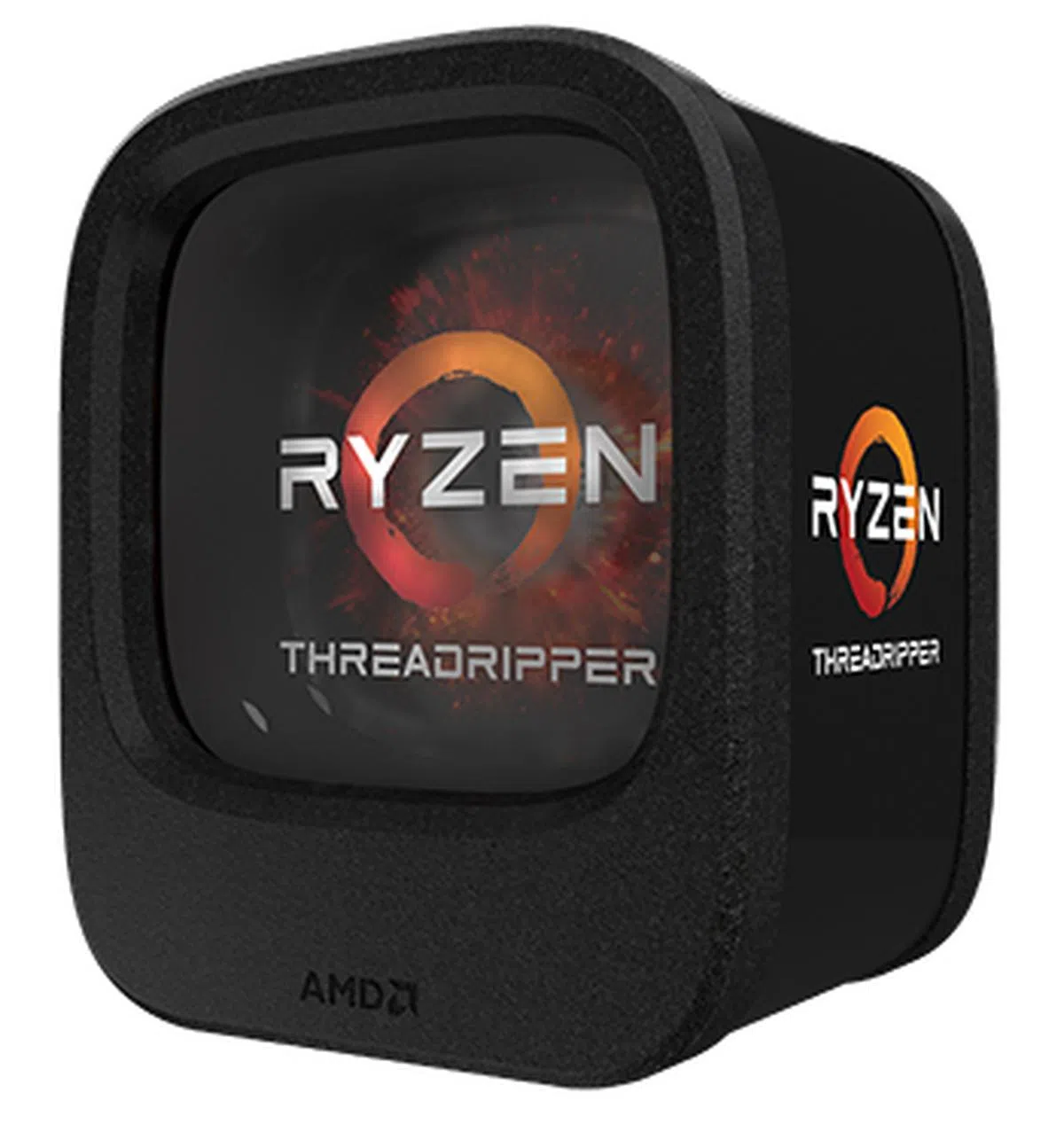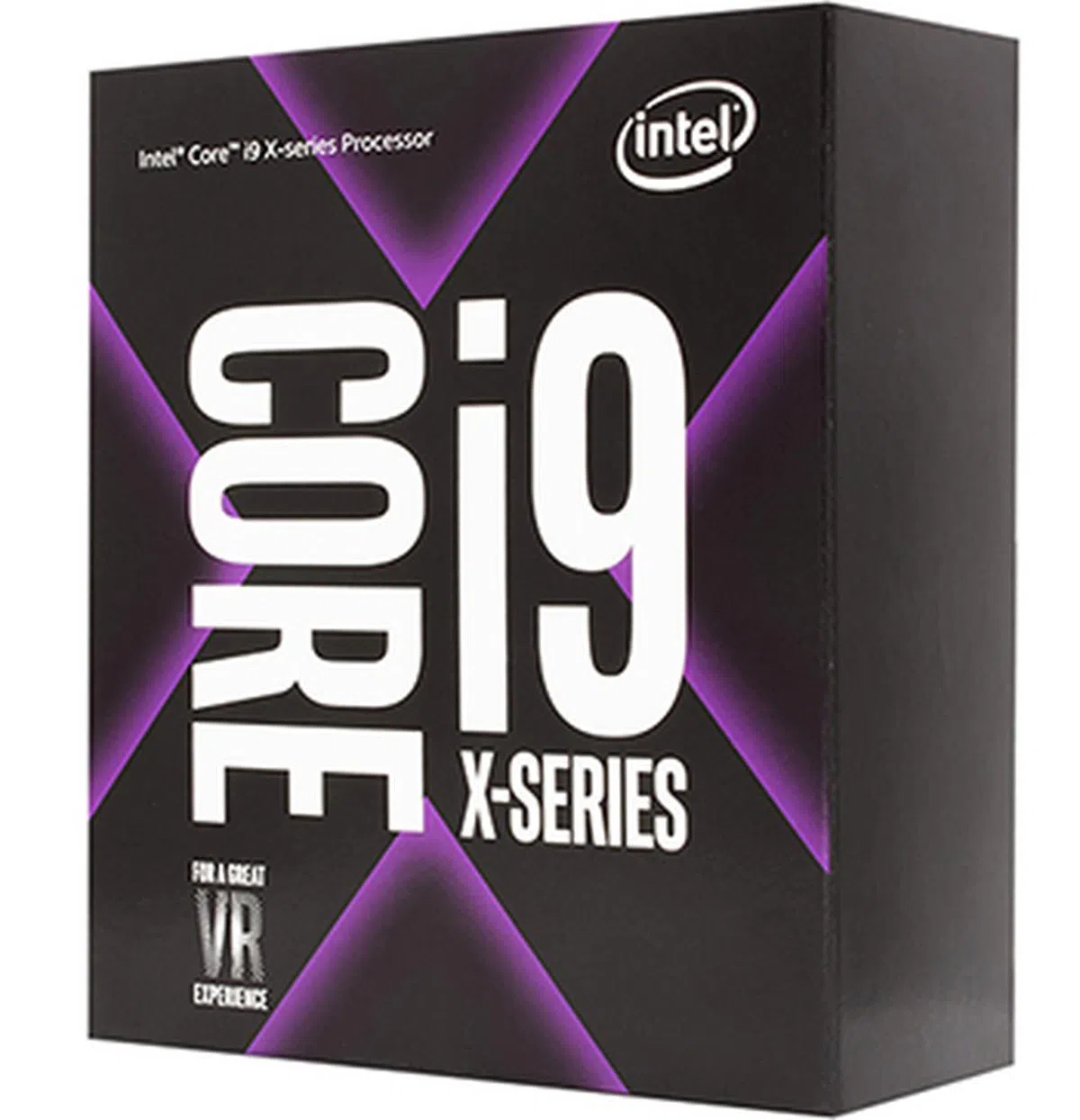AMD Ryzen Threadripper vs. Intel Core i9-7900X: The fastest chips money can buy
AMD is back in the ultra-enthusiast space, and it's looking to make a statement with its Ryzen Threadripper CPUs. How do they stack up against Intel's best?
Note: This article was first published on 10th August 2017.

Meet the Threadripper.
How many cores is too many?
For the first time in years, Intel isn’t alone in the high-end desktop (HEDT) space. AMD is an old challenger made new, and it is bringing the fight to Santa Clara with a new line of enthusiast-grade CPUs that pack more performance than ever.
AMD’s Ryzen Threadripper processors are based on the same Zen architecture as its more mainstream Ryzen chips, but they also share the same DNA as its server-class EPYC processors.
This means familiar SenseMI features like Extended Frequency Range (XFR), Pure Power, and Precision Boost, alongside a highly scalable data fabric that enables support for multi-socket and multi-die configurations and massive I/O expansion options.
Oh, and there’s no forgetting the sheer number of cores and threads packed into these chips, with the line-up so far comprising 8-, 12-, and 16-core models.
All three Threadripper CPUs offer 64 PCIe 3.0 lanes from the CPU, where 60 lanes feed directly to the PCIe and M.2 sockets. The remaining four lanes go to the X399 chipset, which has eight PCIe 2.0 lanes of its own for basic I/O connectivity like USB and other features.

64 PCIe 3.0 lanes from this CPU.
Depending on your PCIe device bandwidth configuration, AMD states the system can support up to seven PCIe devices at any one time, a godsend for content creators wanting to set up a multi-GPU render farm, data scientists, or even a hardcore gamer looking at a 4-way GPU setup.
You’ll notice that these are quite disparate groups of users, but that’s exactly what AMD is hoping for with Threadripper – it wants it to be the chip that can do it all, a processor that will appeal to researchers and scientists, content creators, and the serious Twitch streamer.
Unsurprisingly, that’s similar to what Intel is looking to do with its new Core i9 chips. The 10-core Core i9-7900X is the most powerful chip that the company is offering now, but 12- to 18-core models are arriving over the next couple of months.
That’s a ton of multi-threaded performance just waiting to be tapped into. That said, these are still not CPUs that you’d recommend to your average gamer, even one seeking the best possible performance.
The Ryzen Threadripper 1920X and 1950X cost US$799 and US$999 respectively, with the Intel Core i9-7900X costing US$999 as well. Locally, the Threadripper chips retail for S$1,279 and S$1,589, which tacks on an additional S$200 after a direct currency conversion. That’s about the price of a modest gaming PC, so these HEDT chips are really not targeted at your regular gamer.
Instead, both AMD and Intel are going after power users whose needs span multiple categories. These gamers who create, or creators who game are their target audience, and we’re gearing up for quite the competition.
AMD clearly remains competitive in terms of pricing, offering 16 cores at the same price as Intel’s 10-core chip. However, Intel retains an instructions-per-cycle (IPC) advantage, and generally offers better single-threaded performance, thanks in part to its higher Turbo Boost Max 3.0 clock speeds compared to AMD’s XFR.
It’s something of a toss-up, depending on where your priorities lie. In this review, we’ve pit the AMD Ryzen Threadripper 1920X and 1950X against the Intel Core i9-7900X to give you an idea of how they stack up against each other.
Test Setup
The configurations of the test setups we used for the different processors are listed below. However, the CPU cooler used differed between systems due to compatibility issues across the different sockets.
AMD Ryzen Threadripper
- AMD Ryzen Threadripper 1920X (3.5GHz, 32MB L3 cache) / 1950X (3.4GHz, 32MB L3 cache)
- Thermaltake Floe Riing 360 TT Premium Edition
- ASUS ROG Zenith Extreme
- 4 x 4GB Corsair Vengeance LPX DDR4-2666 (Auto timings: CAS 15-17-17-35)
- NVIDIA GeForce GTX 1080 Ti (GeForce Driver Version 384.94)
- Samsung 850 EVO 250GB SSD
- Windows 10 Home (64-bit)
Intel Core X
- Intel Core i9-7900X (3.3GHz, 13.75MB L3 cache) / Intel Core i7-7740X (4.3GHz, 8MB L3 cache)
- Cooler Master MasterLiquid 240
- Gigabyte X299 Aorus Gaming 9
- 4 x 4GB Corsair Vengeance LPX DDR4-2666 (Auto timings: CAS 15-17-17-35)
- NVIDIA GeForce GTX 1080 Ti (GeForce Driver Version 384.94)
- Samsung 850 EVO 250GB SSD
- Windows 10 Home (64-bit)
Intel Broadwell-E
- Intel Core i7-6950X (3.0GHz, 25MB cache)
- Cooler Master MasterLiquid 240
- ASUS ROG Strix X99 Gaming
- 4 x 4GB Corsair Vengeance LPX DDR4-2666 (Auto timings: CAS 15-17-17-35)
- NVIDIA GeForce GTX 1080 Ti (GeForce Driver Version 384.94)
- Samsung 850 EVO 250GB SSD
- Windows 10 Home (64-bit)
Intel Kaby Lake
- Intel Core i7-7700K (4.20GHz, 8MB L3 cache)
- Cooler Master MasterLiquid 240
- ASUS ROG Maximus IX Formula
- 4 x 4GB Corsair Vengeance LPX DDR4-2666 (Auto timings: CAS 15-17-17-35)
- NVIDIA GeForce GTX 1080 Ti (GeForce Driver Version 384.94)
- Samsung 850 EVO 250GB SSD
- Windows 10 Home (64-bit)
AMD Ryzen
- AMD Ryzen 7 1800X (3.60GHz, 20MB L2+L3 cache)
- Noctua NH-U12S SE-AM4
- Gigabyte Aorus AX370 Gaming 5
- 2 x 8GB Corsair Vengeance LPX DDR4-3000 at 2,666MHz (Auto timings: CAS 16-16-16-36)
- NVIDIA GeForce GTX 1080 Ti (GeForce Driver Version 384.94)
- Samsung 850 EVO 250GB SSD
- Windows 10 Home (64-bit)
[hwzcompare]
[products=609577,609575,609579,609581,596454,584481,590302]
[width=200]
[caption=Test CPUs compared]
[showprices=1]
[/hwzcompare]
Next, here’s a list of the benchmarks used:
- SYSmark 2014 SE
- PCMark 10
- SPECviewperf 12.1
- Cinebench R15
- Handbrake 1.0.7
- 3DMark (2013)
- VRMark
- Ashes of the Singularity: Escalation
- Deus Ex: Mankind Divided
We tested the Threadripper CPUs with their default out-of-the-box settings and Distributed, or Uniform Memory Access (UMA) configuration. These are the same settings you'll find in Creator Mode, and we opted to leave out Game Mode because only older games really benefit from it. Furthermore, the newer games we tested seemed to suffer performance penalties when run in Game Mode.
Performance results
SYSmark 2014 SE
SYSmark is a general productivity benchmark suite that measures the response times of tasks on a PC using real-world applications like Microsoft Office 2013 and Adobe Photoshop and simulated user input. Task response times are used to generate a performance rating that reflects actual user experience, so the faster a PC responds to application workloads, the higher its score will be. The method of measuring response times can take many forms, such as the time it takes for an application to show a pop-up completion message, or how long it takes a progress dialog to disappear and for a user to regain application control.
The 2014 SE version of SYSmark adds a new Responsiveness usage model, where the system's ability to react quickly to user input affects the overall user experience. This means situations where the system needs to respond smoothly and quickly, such as with application launches, multi-tab web browsing, file copying, and background app installation.
The Intel Core i9-7900X took the lead overall here, likely helped along by a combination of strong multi-threaded performance and high Turbo Boost Max 3.0 speeds of 4.5GHz. In comparison, the Ryzen Threadripper 1920X and 1950X have a maximum XFR clock of 4.2GHz.
The results here also give you an idea of exactly what the AMD and Intel HEDT chips are good for. They lagged behind in the Office Productivity benchmark, where the higher clocked quad-core processors had an advantage.
However, the Ryzen Threadripper 1950X and 1920X did particularly well in the Data/Financial Analysis segment, which is more sensitive to higher CPU core counts. That said, Intel looked to have the advantage in the Media Creation benchmark, so it’s possible that the applications used in SYSmark – Adobe Photoshop CS6 Extended, Premiere Pro CS6, and Trimble SketchUp – don’t properly take advantage of Threadripper.


PCMark 10 Extended
PCMark 10 Extended assesses the performance of systems in a variety of workloads, including basic computing tasks, productivity applications, digital content creation, and gaming. Compared to PCMark 8, it also adds in new test metrics, such as app startup times, which quantifies how long it takes to launch a variety of real-world apps, and a rendering and visualization workload to simulate professional graphics and engineering applications. In addition, existing workloads have been updated to reflect modern usage
We’ve also added in a graph to reflect the low-level breakdown of scores to give an idea of performance in individual workloads.
The Intel Core i9-7900X took the pole position overall, where it was around 9 per cent quicker than the Threadripper 1950X. However, they once again showed weakness in basic computing tasks compared to the mainstream quad-core CPUs, such as when working with productivity applications.
Their strengths lie in things like photo editing and rendering and visualization, although the Core i9-7900X took quite a large lead in the latter scenario.


SPECviewperf 12.1
SPECviewperf is used to assess the 3D graphics performance of systems in professional applications. Each individual workload, called a viewset, represents graphics and content from an actual real-world application. SPECviewperf actually runs a total of eight different viewsets, but we’ve picked the four which have the greatest performance variation across CPUs display here.
The 3ds-max viewset comes from traces of the graphics workload generated by 3ds Max 2016, while maya-04 is derived from Autodesk’s Maya 2013 application. The catia-04 viewset involves the numerous rendering modes from the CATIA V6 R2012 application, and includes things like anti-aliasing, depth of field, and ambient occlusion. Finally, the sw-03 viewset comes from SolidWorks 2013 SP1, and involves various rendering modes including environment maps.
The Ryzen Threadripper barely came ahead in the 3ds-max viewset, but it seems like the maya-04 and sw-03 viewsets favor higher clock speeds offered by the Intel Core X chips as Threadripper fell behind together with the other lower clocked processors.

Cinebench R15
Cinebench R15 is a better indicator of Threadripper and the Core i9’s performance because of its ability to utilize up to 256 threads to evaluate a processor’s performance in a photorealistic 3D rendering. We ran both single-core and multi-core benchmarks to evaluate single-threaded performance and multi-threaded scalability here.
The multi-threaded benchmark is where Threadripper really excels. The 1950X handily beats the Core i9-7900X by a good 38 per cent. But to give that more perspective, the latter is in turn more than twice as fast as the quad-core Core i7-7740X Kaby Lake-X chip.
On the single-threaded benchmark relies on things like clock speeds and IPC, which is why it’s Intel’s turn to shine. The high Turbo Boost Max 3.0 speed of the Core i9-7900X enables it to go toe-to-toe with the more aggressively clocked quad-core parts.

Handbrake 1.0.7
Handbrake is a video transcoder that converts videos into a format for use on PCs and portable electronic devices, and is a good indicator of a processor’s video encoding capabilities. YouTube content creators, Twitch streamers, and other video creators will be most interested in this performance metric.
The 16 cores and 32 threads on the Threadripper 1950X helped it edge ahead here while transcoding a 1.5GB .mkv file. That said, there’s just a hair of a difference between the 1950X and the Core i9-7900X, probably due to the fact that Handbrake evinces diminishing returns beyond six cores.
However, it’s important to bear in mind that Threadripper’s encoding speed doesn’t necessarily mean higher overall frame rates. Instead, you should simply expect less of a performance penalty while streaming, rendering, or compiling code in the background.

Temperature and power consumption
To test temperature and power consumption, we ran the 3DMark Fire Strike Extreme Stress test and the energy-01 viewset in SPECviewperf 12.1 respectively, taking note of the peak values the chips achieved. For power consumption, this refers to the total system power draw from the power outlet.
It’s difficult to compare temperatures across all the chips given that we used different coolers, so these figures are better taken as a rough indicator to the temperatures you can expect in a typical gaming scenario (which probably doesn’t stress all the cores anyway).
There are few surprises when it comes to power consumption, and the 12- and 16-core Threadripper processors naturally consume more power. That said, the increase in power draw is less than the proportional increase in core count for the 1950X, so that seems like a win for AMD.


Gaming benchmarks and overclocking
3DMark (2013)
The synthetic 3DMark benchmark tests graphics and computational performance at different resolutions, starting at 1080p and going all the way up to 4K. A series of two graphics test, one physics test, and then a combined test stresses your hardware in turn to assess its performance. And because of the physics test that keeps the GPU load low while running gameplay physics simulations on the CPU, all three 3DMark Fire Strike tests scores also include an element of CPU performance.
We’ve also teased out the Physics and CPU scores for the Fire Strike and Time Spy tests and compiled them in separate tables to give a better idea of how each processor performed.
The Threadripper 1950X was neck-and-neck with the Core i9-7900X across all the benchmarks, an encouraging sign given the initially lackluster 1080p gaming performance of the Ryzen 7 1800X. The 1920X was not far behind, and it became more competitive with the Core i9-7900X as the benchmarks moved to more graphically bound 1440p and 4K scenes.
A look at the Physics and Time Spy CPU scores shows the Threadripper chips coming very close to the Intel Core i9-7900X as well, with the 1950X even outstripping the Core i9 in the Physics test.
The 12-core 1920X deserves praise as well, as it offers very competitive performance for just US$799.



Ashes of the Singularity: Escalation
Ashes of the Singularity: Escalation was one of the first games to be updated with optimizations for Ryzen, and both Threadripper processors come very close to challenging the Intel Core i9-7900X in DirectX 12 mode at 1080p.
Ashes of the Singularity is one of the few CPU-bound games out there, if you’re playing on lower resolutions and settings that is. In DirectX 11 mode and High settings, the two Threadripper processors lag behind the Core i9-7900X by 14 to 20 per cent.
However, this gap narrows as you step up to Crazy settings and 1440p and 4K resolutions. The performance differential narrows even further in DirectX 12 mode, but that’s likely because the low-level API helps alleviate CPU bottlenecks by enabling it to process draw calls more efficiently, which means that the GPU is now the limiting factor.
In the CPU-focused benchmark, the Core i9-7900X still has an advantage, although the Threadripper 1950X isn’t that far behind.


Deus Ex: Mankind Divided
In Deus Ex: Mankind Divided, the limitations of the Threadripper chip become apparent in the less demanding graphical settings as well, where the CPU is the one holding things up.
In fact, the Threadripper 1950X lags slightly behind the 1920X, so it may be that clock speeds matter most here, which would explain the strong performance of the Core i7-7700K. At 1080p and High settings, the Core i9-7900X is a good 21 per cent quicker than the 1950X.
Moving to DirectX 12 actually brings about a performance drop across the board, but it brings out the performance differentials between CPUs, especially at a 1080p resolution. The quad-core Core i7-7740X and Core i7-7700K did best here, and this is one example of the many games that don’t yet benefit from having a ton of cores and threads.

Overclocking
We used AMD’s RyzenMaster utility to overclock the Threadripper processors. This table below summarizes the clock speeds, the voltages we used to achieve them, and the respective performance gains.
Overclocking also disables the 4-core XFR boost, or Turbo Boost on Intel’s end, so the speeds won’t ramp up beyond that.
The Threadripper 1950X posted a very nice improvement of nearly 12 per cent, even though we were only able to achieve a clock speed of 4.025GHz, which is below the top XFR speed of 4.2GHz. However, XFR doesn’t apply across all cores ‒ AMD is quoting a 4-core boost to 4.2GHz ‒ so the overclocked chip has a greater proportion of the cores operating at a higher frequency than they would otherwise be.
We were able to hit a higher clock of 4.25GHz with the 1920X, and that produced a decent 10 per cent jump in performance.
The Core i9-7900X similarly managed a nearly 12 per cent increase, even though the speed topped out at a mere 4.5GHz. That’s where the upper range of the chip’s Turbo Boost Max 3.0 technology is as well, which explains why there’s barely any change in the single-threaded scores in Cinebench R15.
We didn’t have a custom liquid cooling loop to really push the chips, but the consensus among reviewers seems to be that 5.0GHz mark is nearly impossible for Skylake-X without some crazy cooling, which may be a bit of a disappointment for those looking to squeeze out more performance.
CPU (Overclocked) | BCLK | Vcore | CPU Core Ratio | Memory frequency | |
AMD Ryzen Threadripper 1950X (3.4GHz, 32MB L3 cache) | 4.025GHz | 100MHz | 1.4V | Auto | 2,666MHz |
AMD Ryzen Threadripper 1920X (3.5GHz, 32MB L3 cache) | 4.25GHz | 100MHz | 1.3875V | Auto | 2,666MHz |
Intel Core i9-7900X (3.3GHz, 13.75MB L3 cache) | 4.5GHz | 100MHz | 1.22V | 45 | 2,666MHz |
Intel Core i7-7740X (4.3GHz, 8MB L3 cache) | 5.08GHz | 106MHz | 1.36V | 48 | 2,650MHz |
Intel Core i7-6950X (3.0GHz, 25MB L3 cache) | 4.28GHz | 102MHz | 1.38V | 42 | 2,448MHz |
Intel Core i7-7700K (4.2GHz, 8MB L3 cache) | 5.04GHz | 112MHz | 1.38V | 42 | 2,464MHz |
AMD Ryzen 1800X (3.6GHz, 16MB L3 cache) | 4.05GHz | 100MHz | 1.4V | 36 | 2,666MHz |

AMD is back in the game

Threadripper ships with a full complement of installation tools.
It’s safe to say that AMD has left the troubled days of Bulldozer behind it. Ryzen Threadripper is an admirable re-entry into the HEDT market, and it’s looking like a very compelling option compared to Intel’s Core X processors.
One of its biggest selling points is its price, where a 16-core/32-thread chip is going for the same US$999 price tag as Intel’s 10-core/20-thread offering. To be sure, the Intel Core i9-7900X still holds a lead in games and other applications that prioritize higher IPCs and don’t yet properly utilize all those threads on Threadripper, but AMD’s chips serve up excellent performance for heavily threaded applications that do.
The Threadripper 1920X is particularly attractive ‒ it is US$200 cheaper but still manages to outperform the Core i9-7900X in some workloads while coming very close in others.
On top of that, there’s AMD’s refusal to segment its features. While you’d have to shell out US$999 for the 44 PCIe lanes on Intel's chip that will unlock the full potential of Intel’s X299 chipset, for the same price all the Threadripper processors will have 64 PCIe 3.0 lanes.
There’s also none of the confusion that stems from certain ports and features being disabled when other connectors are populated, thanks to the generous provision of PCIe 3.0 lanes from the CPU.
All things considered, it seems difficult to recommend the Intel Core i9-7900X over Threadripper. Intel has the upper-hand in terms of per-core IPC, and it comes ahead in games, but Threadripper does really well in professional applications that properly make use of all its cores and threads.
If you’re a content creator that games on the side, Threadripper is shaping up to be a very strong option. Furthermore, Skylake-X is plagued by heat issues that limit its overclocking headroom and requires an AIO cooler at the minimum, and enthusiasts have turned up their noses at Intel’s use of thermal interface material (TIM) instead of a soldered integrated heatspreader (IHS), which is what Threadripper uses.
The Core i9-7900X is by no means a bad CPU. It’s blazing fast, but it’s also very expensive, which is why Threadripper looks so threatening.
Intel will hit back hard with its 12- to 18-core processors that will arrive over the next couple of months, so we expect it to wrest back the crown in terms of multi-threaded performance, but the flagship Intel Core i9-7980XE will cost an eye-watering US$1,999.
Yes, that’s a big change from the deca-core Core i7-6950X that debuted at US$1,723 just over a year ago, but AMD’s revival has changed the rules of the game somewhat. Intel can no longer impose stratospheric prices with impunity, because there is actually a viable, and cheaper, alternative that is just waiting to be picked up.
It’s the same story with Ryzen. You don’t have to be the absolute fastest to come out a winner, and sometimes it’s all about offering better value for performance that rivals far more expensive competitors.
Welcome back, AMD.
 | |
 | |
 |
Our articles may contain affiliate links. If you buy through these links, we may earn a small commission.

